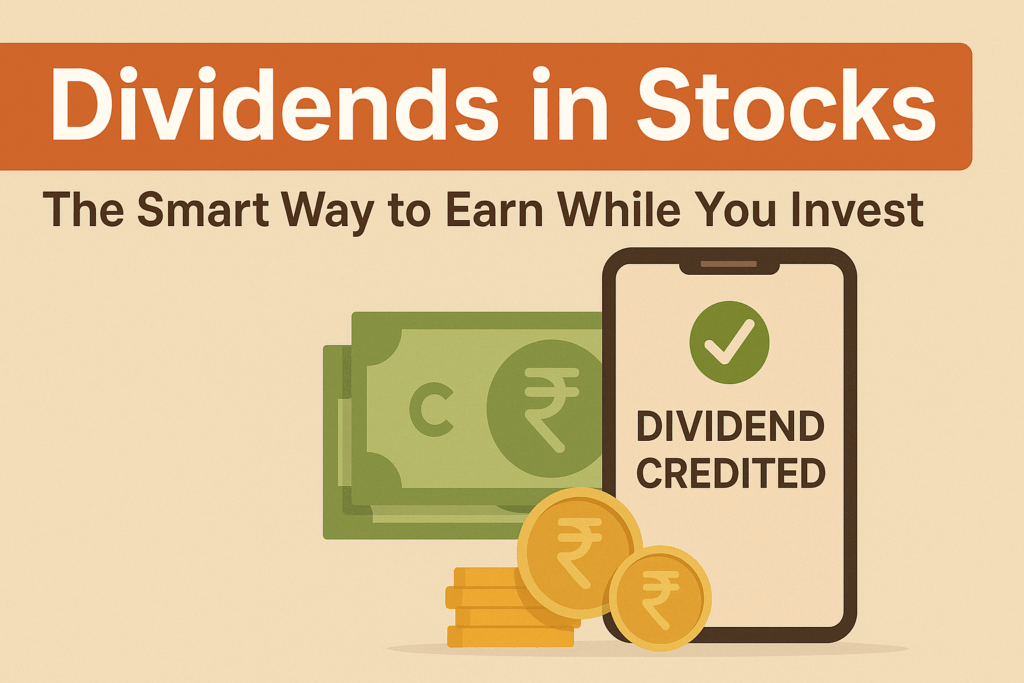When most beginners buy a stock, they think of only one thing —
“Will the price go up?”
But there’s another smart way to earn from the market — one that rewards you for simply holding shares. It’s called dividends in stocks, and it’s a quiet but powerful source of income that many investors overlook.
Even legendary investors like Warren Buffett love dividend-paying companies. Why? Because they help you earn today while building long-term wealth for tomorrow.
So, what exactly are dividends in stocks, and how can they grow your money over time? Let’s break it down.
What Are Dividends?
A dividend is a portion of a company’s profits shared with you — the shareholder.
Instead of using all their profits for expansion, some companies share a part of it as a reward for your trust and patience.
Think of it as the company saying:
“You believed in us — here’s your share of our success.”
You can receive dividends in cash, or occasionally in bonus shares.
In short:
-
The company earns profit.
-
Keeps some for growth.
-
Shares the rest with its investors — you.
That’s how owning a dividend-paying stock can make your portfolio work even when the market takes a nap.
💡 Wouldn’t it be great if your stocks paid you even when they don’t move? That’s what dividend investing can do.
👉 New to the markets? Our Stock Market Training Course explains how dividends fit into your long-term investing plan — from basics to live strategy.
Why Do Some Companies Pay Dividends?
Not every company pays dividends — and that’s not a bad thing. Here’s why some do:
1. Mature and Stable Businesses
Companies like ITC, Hindustan Unilever, or Infosys have strong cash flows and don’t need to reinvest every rupee. They prefer to reward investors with a share of the profit.
2. Attracting Long-Term Investors
Dividends attract serious investors — those who value steady income and financial discipline over hype. Retirees and conservative investors often prefer dividend stocks for this reason.
3. A Signal of Strength
When a company pays dividends consistently, it sends a message:
“We’re profitable, confident, and here for the long run.”
It’s a subtle sign of management’s stability and trustworthiness.
👉 Want to learn how to identify such companies? Explore our Value Investing Course and discover what makes a stock truly worth holding.
Dividends vs. Growth Stocks
Every investor’s portfolio tells a story. Some chapters are about steady income, others about growth.
Here’s how they compare:
| Type | Description | Examples | Pros | Cons |
|---|---|---|---|---|
| Dividend Stocks | Share part of profits as cash | ITC, Coal India | Regular income, stability | Slower price growth |
| Growth Stocks | Reinvest profits for faster expansion | Zomato, Paytm | High potential returns | No cash payouts, more volatility |
Pro Insight:
The smartest investors own a bit of both — dividend stocks for income, and growth stocks for excitement.
How Dividends Help You Build Wealth
1. Regular Passive Income
Imagine this: you own 1,000 shares of a company that pays ₹20 per share annually.
That’s ₹20,000 in your account — without selling anything.
It’s money that quietly flows in while you focus on your goals.
2. Compounding Magic
Reinvest those dividends to buy more shares, and your next payout grows even bigger.
That’s the beauty of compounding — the more you stay invested, the faster your wealth snowballs.
💡 Did you know? Reinvesting dividends can nearly double your long-term returns compared to taking them as cash.
Try it yourself using our SIP Calculator — you’ll be amazed how small reinvestments create big results.
3. Protection in Rough Markets
When the market slows down, dividend income acts like a safety net.
Even if prices don’t rise, your portfolio still pays you to stay patient.
Example: ITC — The Dividend King of India
Few Indian companies reward their shareholders like ITC.
In FY25, ITC paid a dividend of ₹14.25 per share, returning nearly its entire profit to investors. For long-term holders, these payouts have been like a second salary — reliable and rewarding.
It’s proof that mature businesses can build wealth not only through growth, but also through steady, consistent income.
Want to find similar companies?
Try our NSE Stock Screener to filter stocks with solid dividend records and strong fundamentals.
How to Start with Dividend Investing
If you’re just starting out, here’s a simple roadmap:
-
Pick strong companies with a history of steady profits.
-
Check payout consistency — look beyond one-time high dividends.
-
Diversify across sectors.
-
Reinvest dividends to build compounding wealth.
-
Be patient. Dividend investing rewards those who stay the course.
Want hands-on guidance? Begin your learning journey with our Stock Market Training — trusted by beginners across India.
❓ Frequently Asked Questions About Dividends
1. What exactly are dividends?
They’re cash or stock rewards companies give shareholders as part of their profits — your share of the business success.
2. How often are dividends paid?
Most Indian companies pay once or twice a year. Some global firms pay quarterly.
3. Are dividends guaranteed?
No. They depend on profits and board decisions. But established companies usually maintain regular payouts.
4. Are dividends taxable?
Yes. In India, dividends are added to your income and taxed as per your slab rate.
5. Which is better — dividend or growth investing?
They serve different goals. Dividends offer stability and income, while growth stocks offer potential and excitement. The best portfolios blend both.
Final Thoughts
Dividends may not grab headlines like fast-moving growth stocks — but they often deliver the most reliable results.
They pay you to stay invested, cushion market dips, and when reinvested, quietly multiply your wealth.
So next time you look at your trading app, don’t just ask,
“Will this stock go up?”
Also ask,
“Will this stock pay me to hold it?”
Because sometimes, the best kind of wealth doesn’t shout —
It simply appears on your phone as:
“Dividend Credited.”


